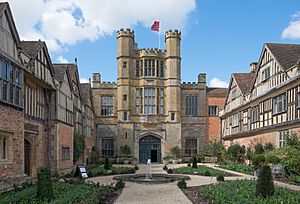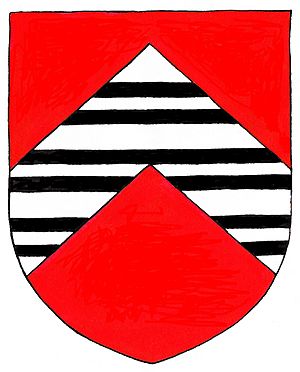Francis Throckmorton facts for kids
Quick facts for kids
Francis Throckmorton
|
|
|---|---|
| Born | 1554 |
| Died | July 10, 1584 (aged 29–30) Tyburn, Middlesex
|
| Cause of death | Hanging |
| Education | University of Oxford, Inner Temple, London |
| Occupation | Lawyer |
| Known for | Throckmorton Plot |
| Criminal charge(s) | Treason |
| Spouse(s) | Anne Sutton |
| Children | John Throckmorton |
| Parents |
|
| Relatives | Sir Nicholas Throckmorton, Nicholas Vaux, 1st Baron Vaux of Harrowden, Elizabeth Throckmorton George Puttenham, Sir Edward Sutton, 4th Baron Dudley |

Sir Francis Throckmorton (born 1554 – died 10 July 1584) was an English lawyer. He is best known for being involved in a secret plan against Queen Elizabeth I of England. This plan is known as the Throckmorton Plot.
Contents
Who Was Francis Throckmorton?
Francis Throckmorton was born in 1554. His father was Sir John Throckmorton, who was a top legal advisor to Queen Mary I. Francis's family, the Throckmortons of Coughton Court, was quite important. His uncle, Sir Nicholas Throckmorton, was a well-known diplomat for Queen Elizabeth I.
Francis's Family Life
In 1567, Francis was set to marry Anne Sutton. She was the daughter of Sir Edward Sutton, 4th Baron Dudley. Anne moved in with Francis's mother to be raised by her. They officially married around 1571. Francis and Anne had one son named John.
His Education and Beliefs
Francis Throckmorton studied at Hart Hall in Oxford starting in 1572. Later, in 1576, he went to the Inner Temple in London to study law. While at Oxford, he became interested in the Catholic faith. When some Catholic leaders came to England in 1580, Francis helped them.
The Plot Against Queen Elizabeth I
In 1580, Francis Throckmorton traveled to Europe with his brother Thomas. There, he met with English Catholics who were unhappy with Queen Elizabeth I. In Paris, he met agents working for Mary, Queen of Scots. Mary was imprisoned in England at the time.
Planning a Secret Invasion
When Throckmorton returned to England in 1583, he became a messenger. He carried secret messages between Catholics in Europe, Mary, Queen of Scots, and the Spanish ambassador, Bernardino de Mendoza.
The secret plan was to invade England. A French army, led by the Duke of Guise, or Spanish and Italian forces, would attack. Their goal was to free Mary, Queen of Scots, and bring back the Catholic Church to England. Throckmorton used his house in London as a meeting place for the plotters.
Secret Messages and Discovery
Throckmorton also delivered Mary's letters to the French ambassador, Michel de Castelnau. In 2023, secret coded letters from Mary were found and decoded. In these letters, Throckmorton was called "Monsieur de la Tour."
Sir Francis Walsingham, Queen Elizabeth I's spymaster, became suspicious of Throckmorton. In October 1583, Throckmorton was arrested. A search of his house found evidence against him. After intense questioning, Throckmorton admitted his part in the plot. The plan involved an invasion and a Catholic uprising inside England.
Trial and Execution
Throckmorton was put on trial in London on 21 May 1584. He later took back his confession, but other evidence still showed his guilt. His arrest stopped the plot and led to the Spanish ambassador being sent out of England.
Francis Throckmorton was found guilty of high treason. This means he was found guilty of betraying his country. He was executed by hanging at Tyburn on 10 July 1584. On the scaffold, he again said he was innocent, claiming his confession was made only because he hoped to be pardoned.
Throckmorton in Stories
Sir Francis Throckmorton has appeared in movies and books.
- In the film Elizabeth: The Golden Age, he is played by Steven Robertson. The movie shows him asking for help from his cousin, Elizabeth Throckmorton.
- He is also in Ken Follett's historical novel A Column of Fire. The book describes how he became involved in the plot and how he was caught.


